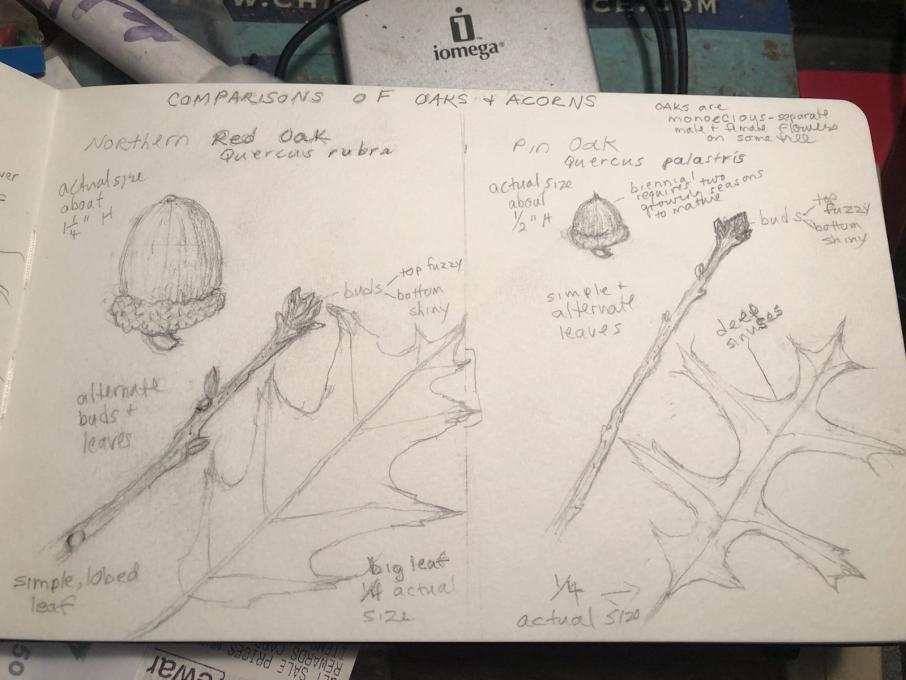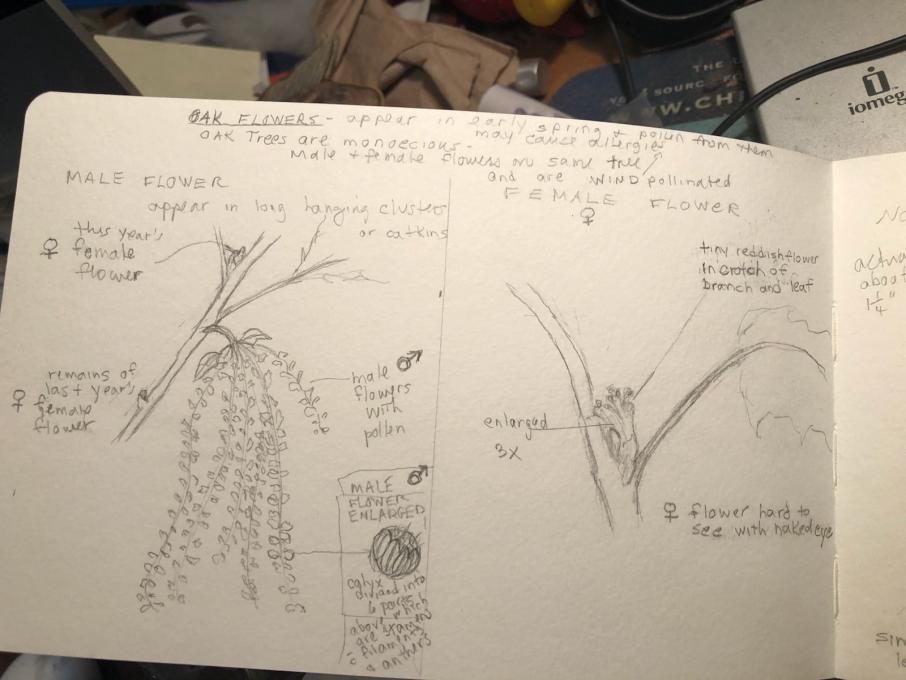The Cornell Lab Bird Academy › Discussion Groups › Nature Journaling and Field Sketching › The Power of Comparison
-
I compared andromeda and leucothoe, both planted in my yard. I chose these because of some superficial similarities: general leaf shape, presence of dried flowers from last season, new spring flowers forming, overall shape and size of the shrub. By looking more closely, I could see that the form and branching was quite different. The arrangement of leaves (alternate on both) showed some observable differences, too. The andromeda appears from a distance has a rosette of leaves at the end of each branch. The leucothoe has alternating leaves at each node, and the stem itself zig-zags at each node, whereas the andromeda's stem remains straight at the nodes.

-
It's spring, so there's new growth in our yard. I compared the new growth of an evergreen and a perennial. Enlightening! When writing and recording as descriptive, the location/placement of info. seems self-evident. Artful? A goal for sure, as is figuring out how to insert image.< ;

-
I did a comparison of two flowering plants that are forming mattes in my currently fallow garden area. It really did help to focus attention on various details doing the comparison. The two form very dense mattes, and appears there is some type of competition going on between them. Putting two items on the same page is a great technique!

-
I compared two plants in my house. It's been a bit tricky to get outside to do it while hiking with two kids and my husband (also I've been birding! Working on learning the sound!) Just as in the above video, the longer I looked at the plants, the more that I noticed and started off seeing their differences, but after a bit of time started to note some similarities that weren't readily obvious. I enjoyed the focused study! I think adding a lot of different type of information - measurements, height, shape, etc. gives a greater picture of something and in the future can help with identification or with recalling the moment.

-

-
At first I didn't think that many details was that important on my first mushroom. Then when I started the second mushrooms I started to realize the differences. Some where very obvious but I wouldn't think it record the texture of the stalk on the first one if I didn't see how textured and complex the second one was. I started to compare everything: colors, shapes, where it grew, etc. It seems like that would come naturally but this activity really did forces me to pull out those details that we may take for granted on first glance.

-
 These are two conifers. I first noticed their different shapes. I continued to draw after I wrote my notes. Maybe next time I'l take my notes on the side and add them to the page after the drawings are done. I wanted to sketch the cones on the page but there is no room for that.
These are two conifers. I first noticed their different shapes. I continued to draw after I wrote my notes. Maybe next time I'l take my notes on the side and add them to the page after the drawings are done. I wanted to sketch the cones on the page but there is no room for that. -
 I decided to compare 2 beetles. They had more differences than similarities. I made a table with some info about them.
I decided to compare 2 beetles. They had more differences than similarities. I made a table with some info about them. 

-
I like your study and table very much
-
@Isabel Thank you so much. It took a long time to complete, but I learned a lot . I really enjoy reading and seeing other student posts! Avery
-
The beetle study is just sooo pretty and I don't like beetles! Did you use watercolor or watercolor pencils?
-
@Deborah Hi, thanks so much. I mostly used watercolor and some thin marker in tight dark places.
-
-
I haven't done many comparison studies, but I have done some. I thought the comparison study helped me focus better on the unique characteristics of the black-capped and the chestnut-back chickadees that I was comparing, and the similarities between them. I learned that creating a comparison study can help you distinguish different and similar characteristics about two different things. When balancing drawing and writing in my journal, I think I will balance them depending on what I want to do that day, and what I want to write/draw about.
-
 I have been observing this two different bird species for three months. Both are black and nest in the bougainvillea in front of my house. When I made this comparison study I notice that the Great-tailed Grackle (left) has yellow eyes, is bigger with longer tail and beak than the Cowbird (right). Maybe he has a stronger beak so he can eat anything, he can eat from the garbage bags. The Cowbird is chubby, has red eyes and is not aggresive as the Great tailed Grackle.
I have been observing this two different bird species for three months. Both are black and nest in the bougainvillea in front of my house. When I made this comparison study I notice that the Great-tailed Grackle (left) has yellow eyes, is bigger with longer tail and beak than the Cowbird (right). Maybe he has a stronger beak so he can eat anything, he can eat from the garbage bags. The Cowbird is chubby, has red eyes and is not aggresive as the Great tailed Grackle. -
Very nice watercolors and study!
-
Beautiful bird renderings!
-
I'm captivated! Beautiful!
-
I appreciate these watercolors of birds that I have so often seen.
-
-
We were in Florida back in February and we were camping at Devil’s Den in Williston . The days were warm and I sat at a picnic table and drew these two items. They have totally different textures and I was trying to use the hatching, contour hatching, and some scribbling in this exercise. I learned that these techniques help to convey depth and texture like whether something is smooth or rough.

-
 I compared the leaves of three backyard plants. The rhododendron and the laurel were very similar and symmetrical while the azalea was quite different with a rather random, but connected series of paths, suggesting that the laurel and rhododendron might be related. The actual rhodie and laurel plants themselves are quite different though and the laurel shape is more closely related to the azalea in shape with multiple stems coming from the ground rather than one or two stems rising with multiple off shoots like the rhodie.
I compared the leaves of three backyard plants. The rhododendron and the laurel were very similar and symmetrical while the azalea was quite different with a rather random, but connected series of paths, suggesting that the laurel and rhododendron might be related. The actual rhodie and laurel plants themselves are quite different though and the laurel shape is more closely related to the azalea in shape with multiple stems coming from the ground rather than one or two stems rising with multiple off shoots like the rhodie. -
Great toi have a chance to record and define what I see.

-
Just exactly that..I need to focus to even see the differences. It’s a discipline thing. Drawing , writing, recording come naturally if you are concentrating on only one or two items. the short notation with a dot before it works for me interspersed with the drawings.The research that follows, the questions asked are equally important to me.
-
 I finally completed my comparison of the Junco and Chickadee both of which frequent our feeder. I am still not drawing from the real thing - this is from the Sibley Field Guide but it did allow me to really see the differences in their form and to focus on differences in behaviour. No modelling in the drawings but maybe I will do that later. Scribbling is useful.
I finally completed my comparison of the Junco and Chickadee both of which frequent our feeder. I am still not drawing from the real thing - this is from the Sibley Field Guide but it did allow me to really see the differences in their form and to focus on differences in behaviour. No modelling in the drawings but maybe I will do that later. Scribbling is useful. -
I have a small grove in my garden is covered with Lesser Prewinkle. Only two yards from it, Balkan Anemones have been conquering the gravel path. The flowers of both plants have a very similar purple violet color and the plants are also similar in height. ( a few inches) . But all the rest is quite different: I noticed different shapes of the leaves (shiny and single /opposite and smooth edged versus mat and composite/ dented). Flower stem were bold versus hairy. The five petals of the Prewinkle merge into a tube shape at the base of the flower with five sepals. The Anemone has about fourteen petals, but I couldn’t find any sepals! This triggered my curiosity and after consulting some botanical websites, the mystery was solved: The ‘petals’ seem to be false and are actually colored sepals! This was a true eye opener. Without this drawing excercise, it would never come to my mind that I was looking at a flower chalice..

-
Finally getting back to the class after a longer hiatus during the holidays that expected. For this exercise I studied two nests, it was a good way to make more focused observations than just looking at one object.

-
Your nest drawings are wonderful. I find drawing nests very challenging, because even though they appear messy, they actually have organization and symmetry. You did a great job! 👍🏻
-
-
This exercise helped me really observe the different attributes of the two types of tree flowers. I think it will help me identify species.

-
It is still too cold to do anything outside here, where I live. I collected a group of tiny coniferous cones that were all attached together on a branch (group of branches) on the ground where they had fallen, and used these in a comparison with a larger pine cone. The pine cone was a little smaller than fist sized and the group of 9 small cones were similar or just a little smaller than the pine cone. I wish I knew what kind of tree the tiny cones were from (they are not hemlock, as I do know what those are like). I honestly can't say what I learned from this, aside from careful observation of details which I think I would have done just from the fact of drawing them anyway.
-
This exercise was not too dificult to do. Focus in the subjects allow me to think more about real structure. I think I made 2 attempts before I was happy with what I saw. Using what is taught, helped me to catch the volume of the birds (at least I think so). I made a list of the birds that will be add in the reply. I don't think I missed any bird.

-
 The list of birds observed
The list of birds observed
-
-
 1. A deeper level of detail was observed on each plant during the comparison study. Working back and forth between each plant/sketch provided specific items to look at on each.
2. I like an equal balance of writing/data and drawing in my journal. I feel all provide valuable observation cues and information for reference later.
1. A deeper level of detail was observed on each plant during the comparison study. Working back and forth between each plant/sketch provided specific items to look at on each.
2. I like an equal balance of writing/data and drawing in my journal. I feel all provide valuable observation cues and information for reference later. -

-
I went walking on the nearby riverwalk without know what to compare. There were 2-3 dozen mallards in one area so I thought I'd just observe them but as I did, I began to notice differences. My pare was not laid out as a comparison study because I thought I'd just be observing them!


-
 This is my comparison study, holly and hemlock. I did see many differences that I might not have otherwise noted.
This is my comparison study, holly and hemlock. I did see many differences that I might not have otherwise noted. -
- Really nice study!
-
-


Read More:
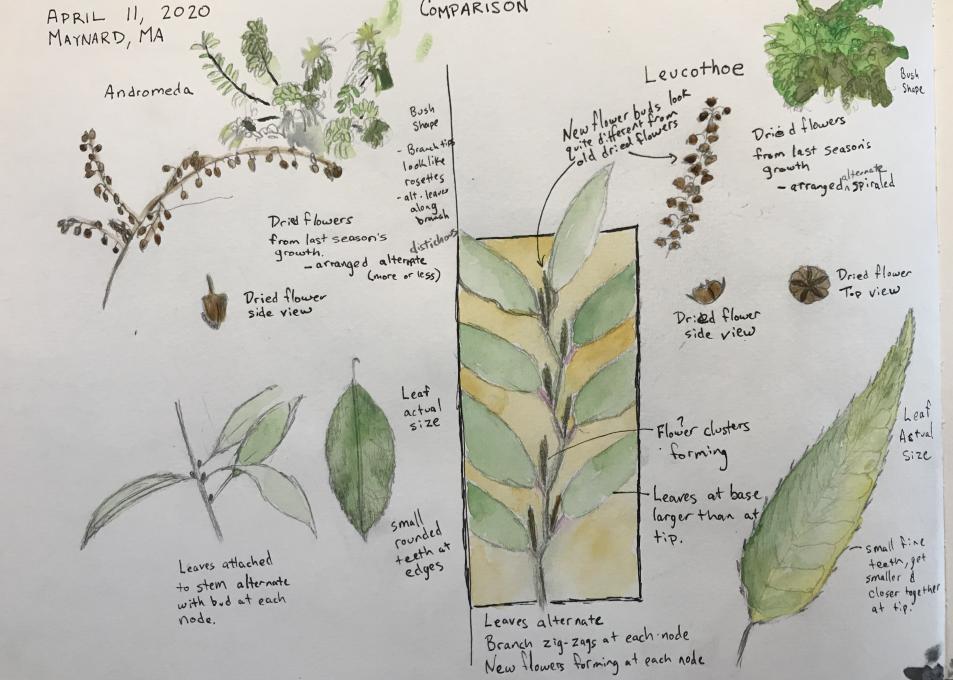
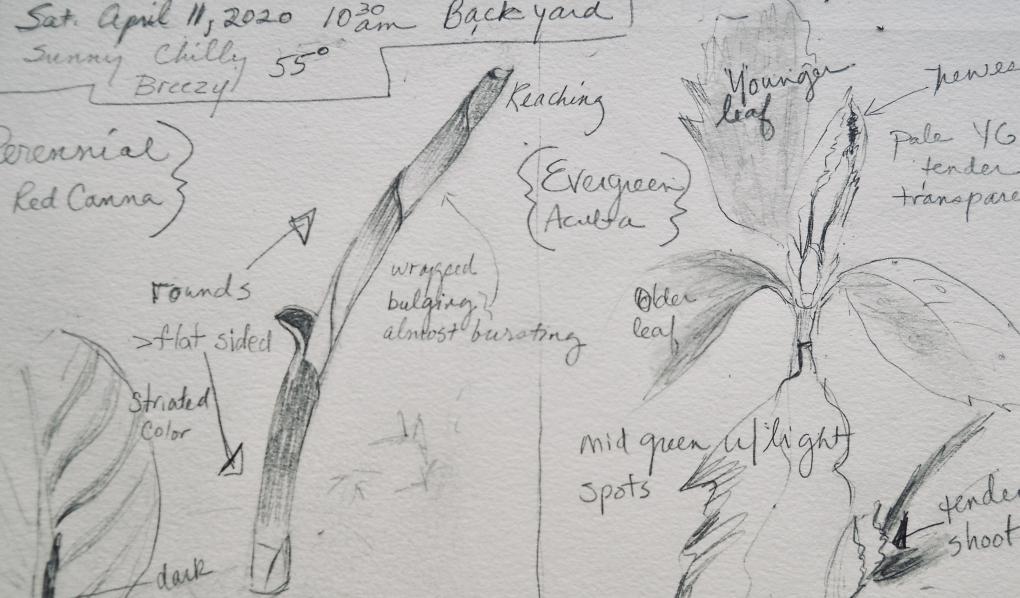
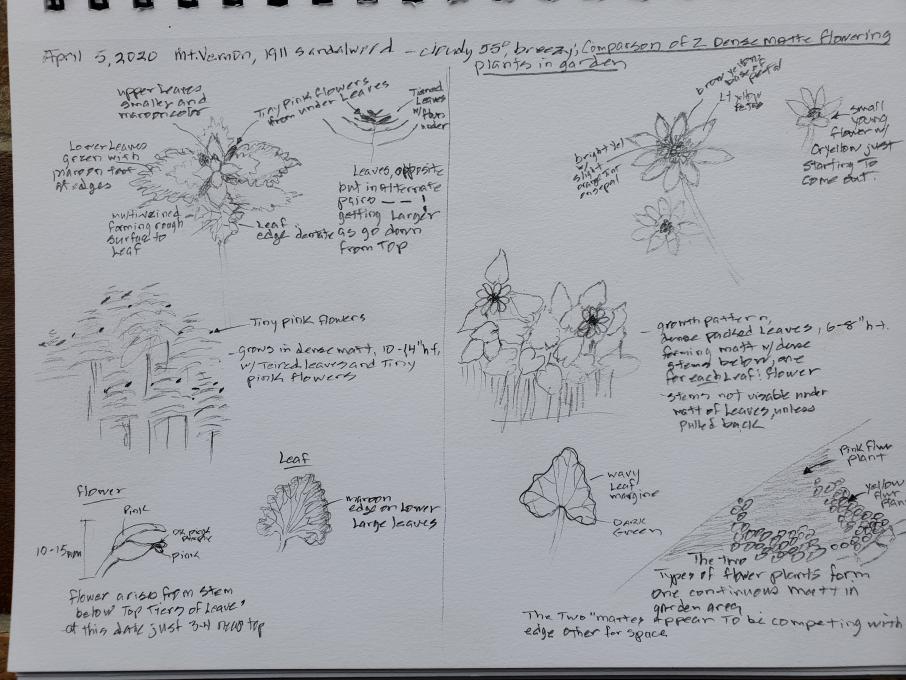
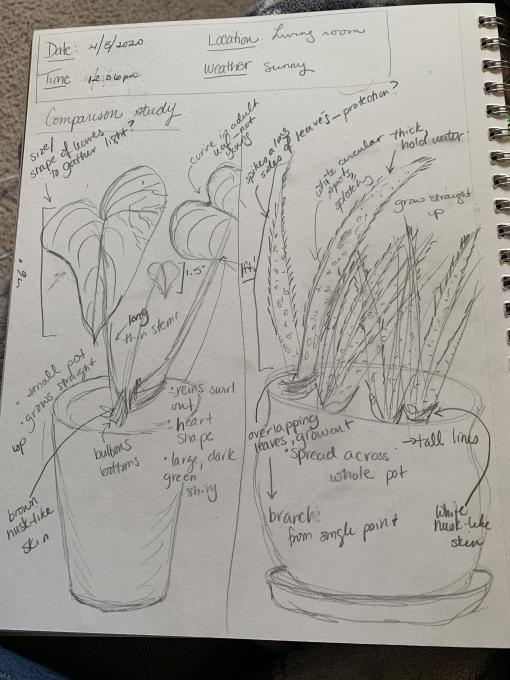
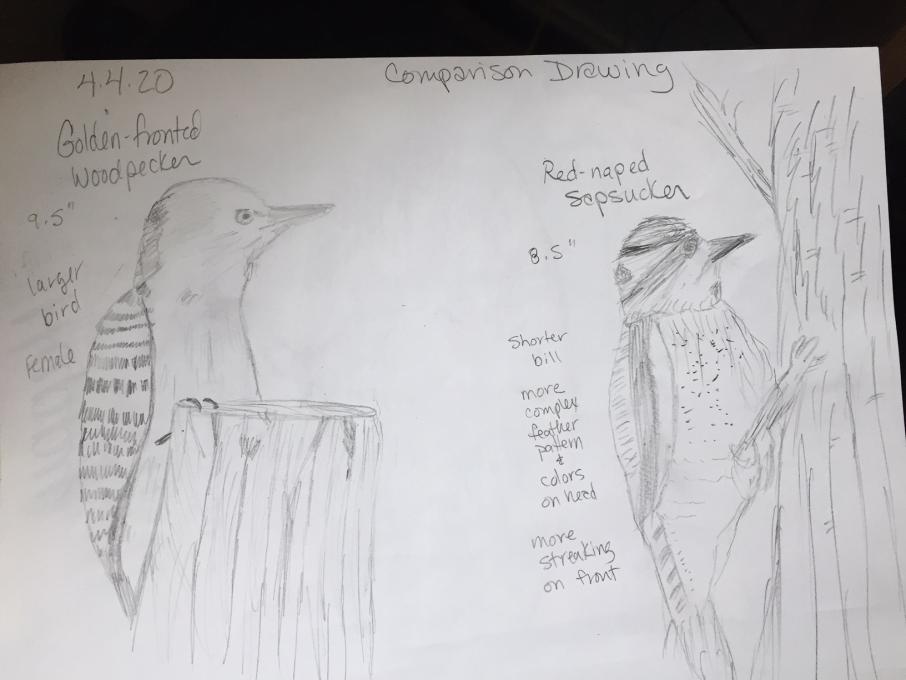
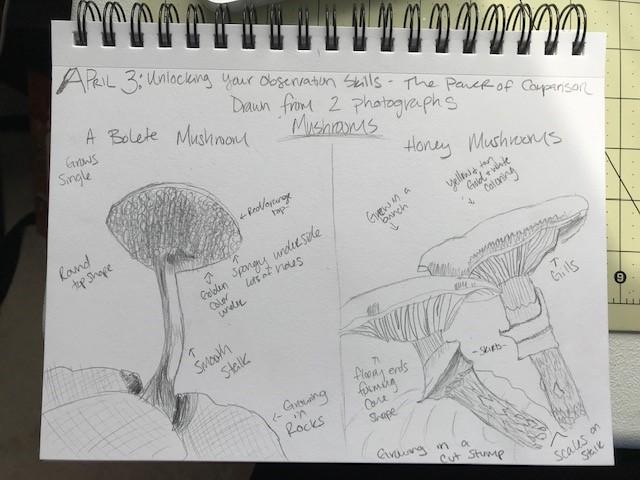
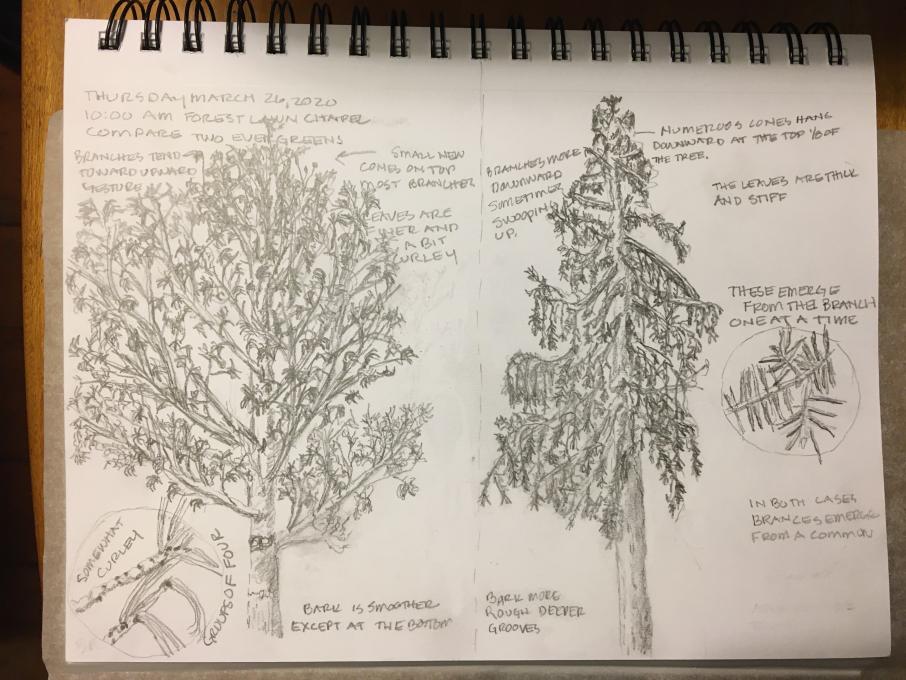 These are two conifers. I first noticed their different shapes. I continued to draw after I wrote my notes. Maybe next time I'l take my notes on the side and add them to the page after the drawings are done. I wanted to sketch the cones on the page but there is no room for that.
These are two conifers. I first noticed their different shapes. I continued to draw after I wrote my notes. Maybe next time I'l take my notes on the side and add them to the page after the drawings are done. I wanted to sketch the cones on the page but there is no room for that. 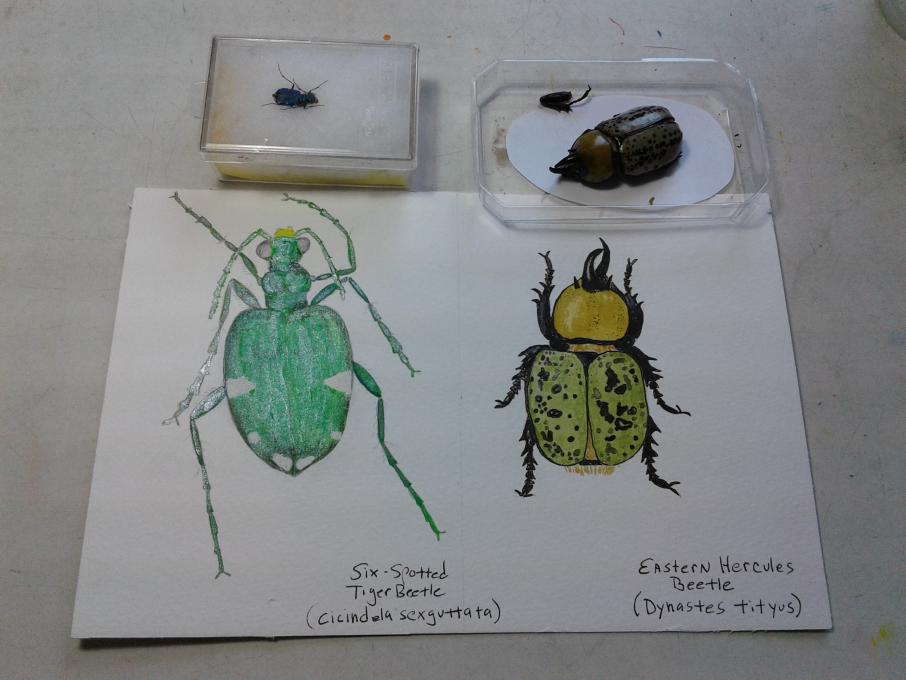 I decided to compare 2 beetles. They had more differences than similarities. I made a table with some info about them.
I decided to compare 2 beetles. They had more differences than similarities. I made a table with some info about them. 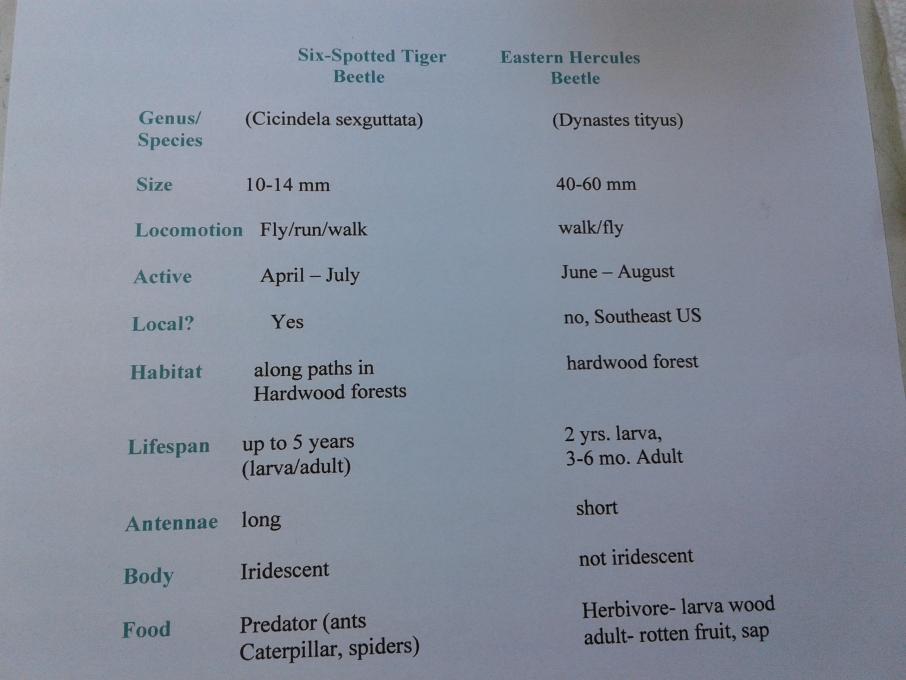
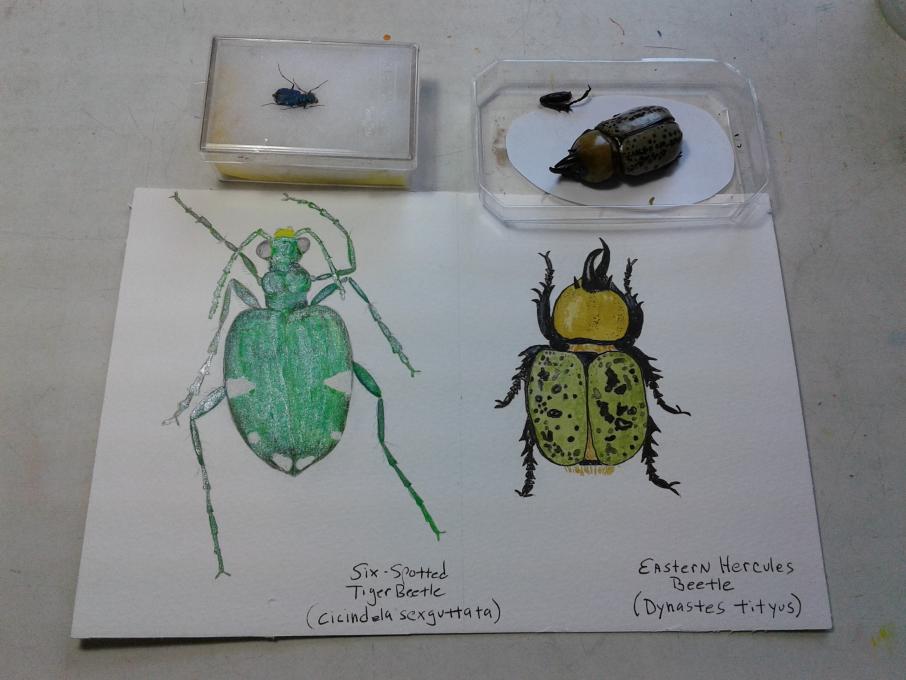
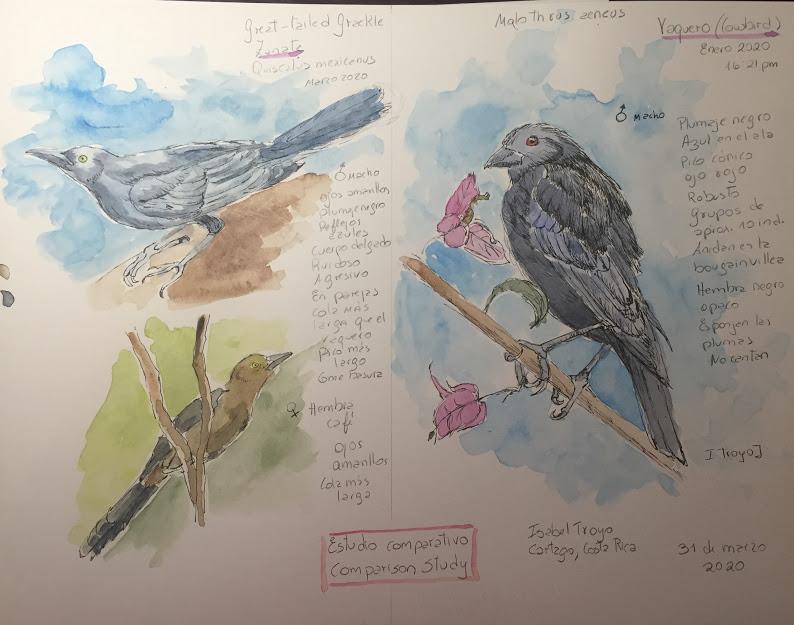 I have been observing this two different bird species for three months. Both are black and nest in the bougainvillea in front of my house. When I made this comparison study I notice that the Great-tailed Grackle (left) has yellow eyes, is bigger with longer tail and beak than the Cowbird (right). Maybe he has a stronger beak so he can eat anything, he can eat from the garbage bags. The Cowbird is chubby, has red eyes and is not aggresive as the Great tailed Grackle.
I have been observing this two different bird species for three months. Both are black and nest in the bougainvillea in front of my house. When I made this comparison study I notice that the Great-tailed Grackle (left) has yellow eyes, is bigger with longer tail and beak than the Cowbird (right). Maybe he has a stronger beak so he can eat anything, he can eat from the garbage bags. The Cowbird is chubby, has red eyes and is not aggresive as the Great tailed Grackle. 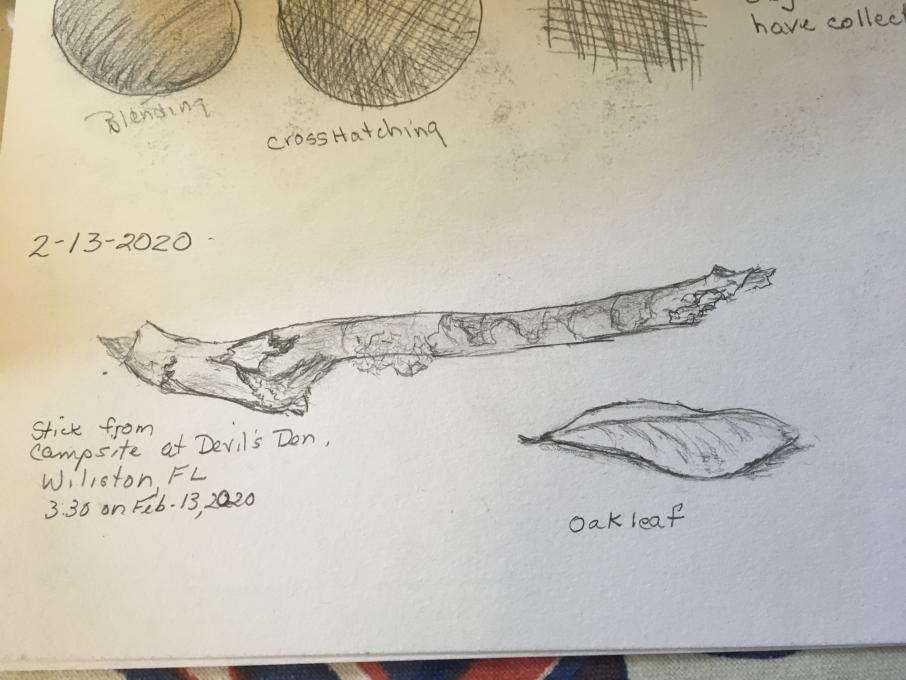
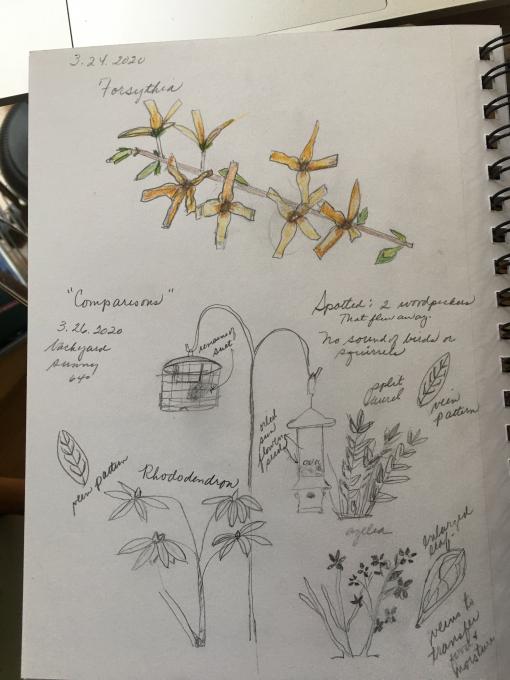 I compared the leaves of three backyard plants. The rhododendron and the laurel were very similar and symmetrical while the azalea was quite different with a rather random, but connected series of paths, suggesting that the laurel and rhododendron might be related. The actual rhodie and laurel plants themselves are quite different though and the laurel shape is more closely related to the azalea in shape with multiple stems coming from the ground rather than one or two stems rising with multiple off shoots like the rhodie.
I compared the leaves of three backyard plants. The rhododendron and the laurel were very similar and symmetrical while the azalea was quite different with a rather random, but connected series of paths, suggesting that the laurel and rhododendron might be related. The actual rhodie and laurel plants themselves are quite different though and the laurel shape is more closely related to the azalea in shape with multiple stems coming from the ground rather than one or two stems rising with multiple off shoots like the rhodie. 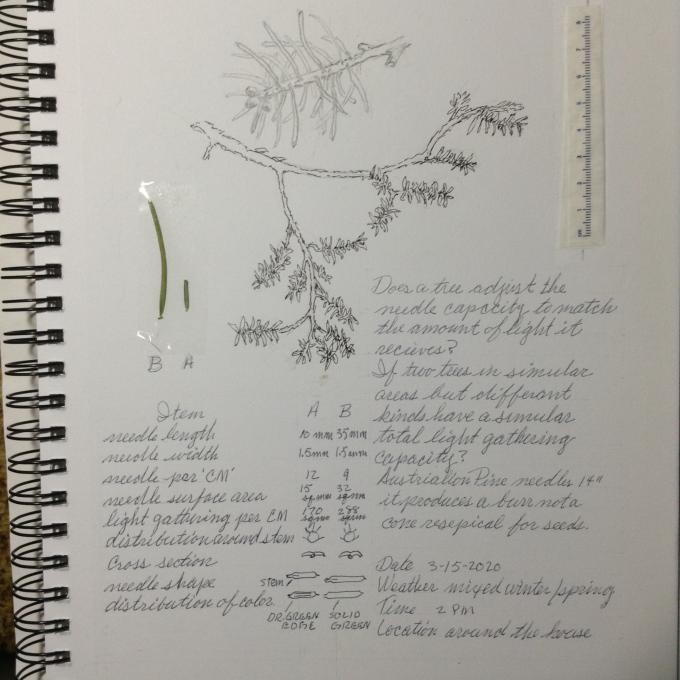
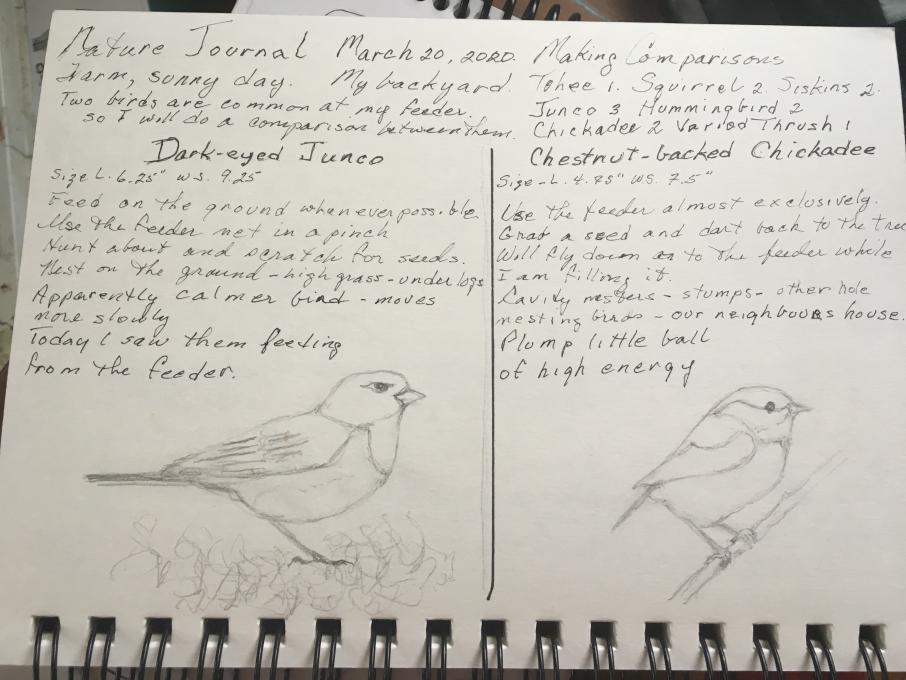 I finally completed my comparison of the Junco and Chickadee both of which frequent our feeder. I am still not drawing from the real thing - this is from the Sibley Field Guide but it did allow me to really see the differences in their form and to focus on differences in behaviour. No modelling in the drawings but maybe I will do that later. Scribbling is useful.
I finally completed my comparison of the Junco and Chickadee both of which frequent our feeder. I am still not drawing from the real thing - this is from the Sibley Field Guide but it did allow me to really see the differences in their form and to focus on differences in behaviour. No modelling in the drawings but maybe I will do that later. Scribbling is useful. 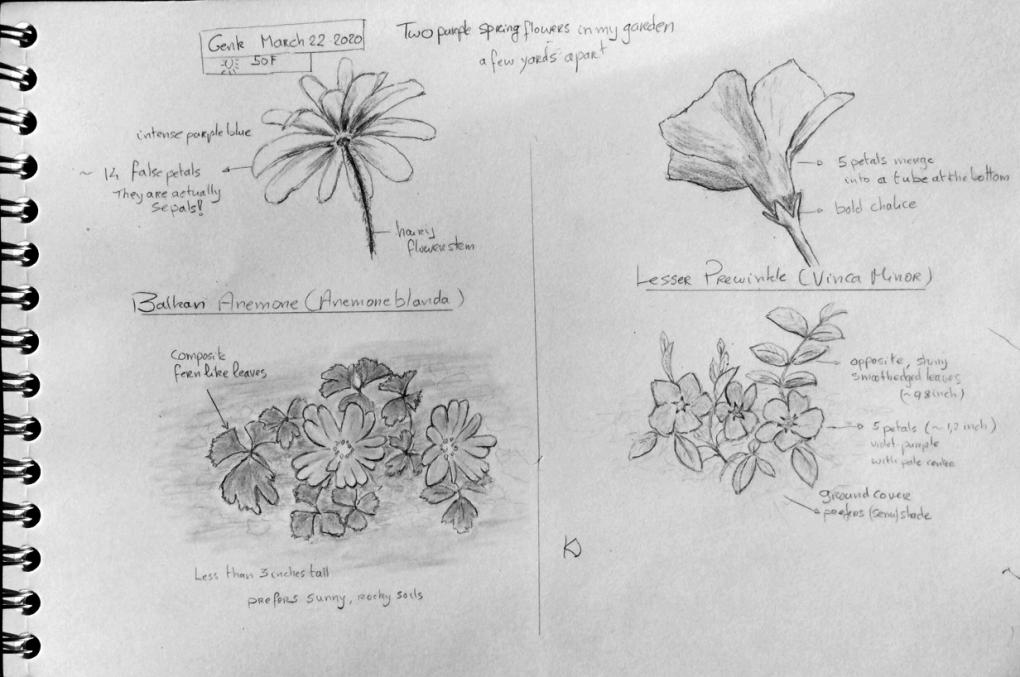
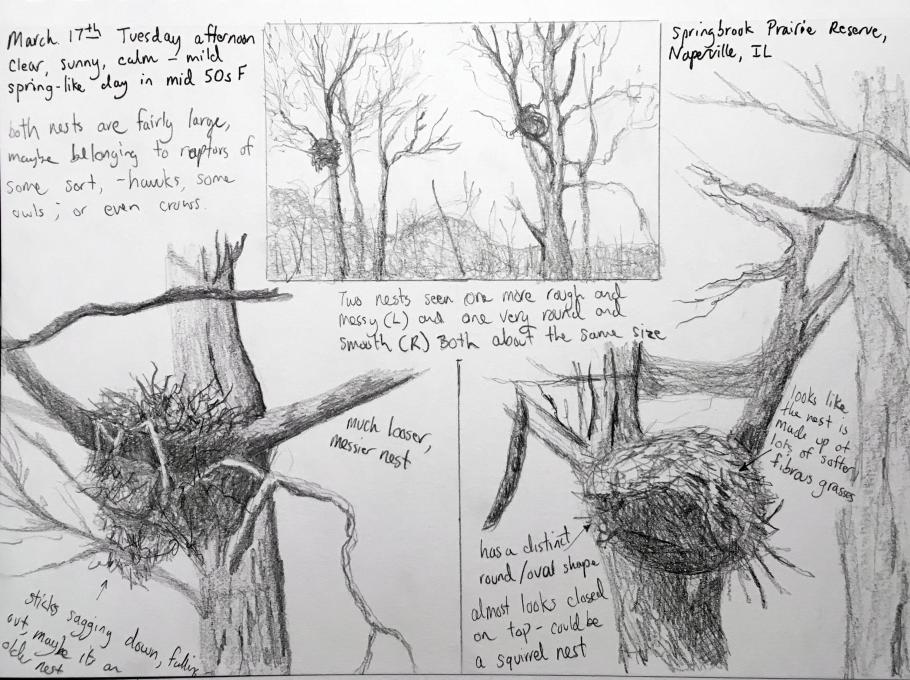
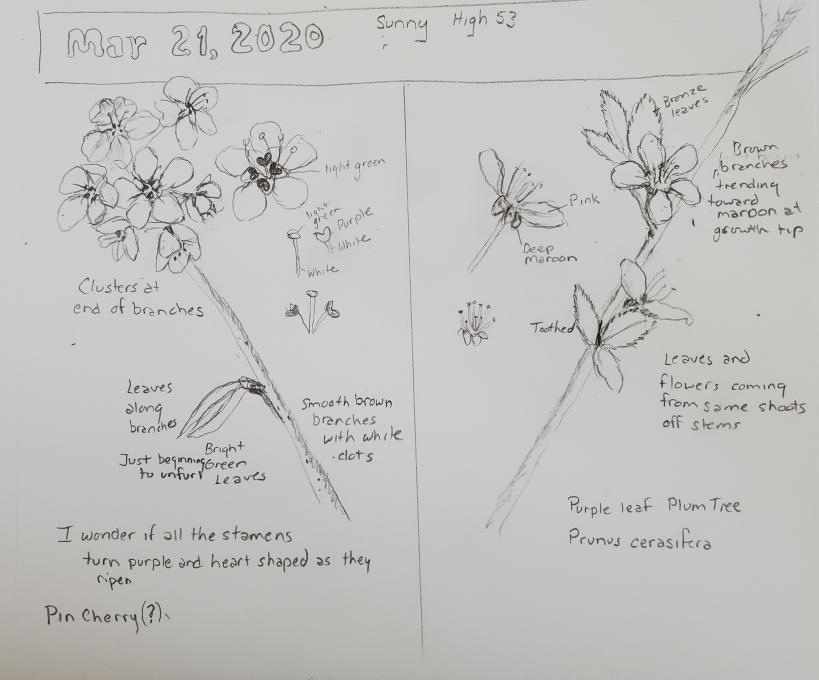
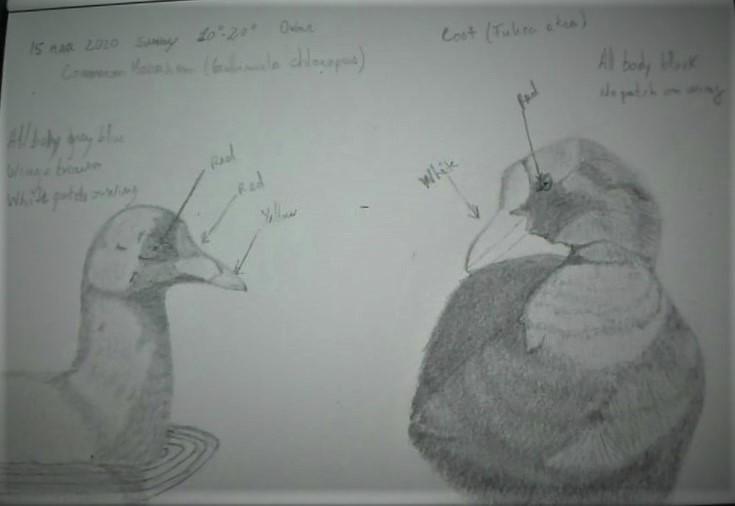
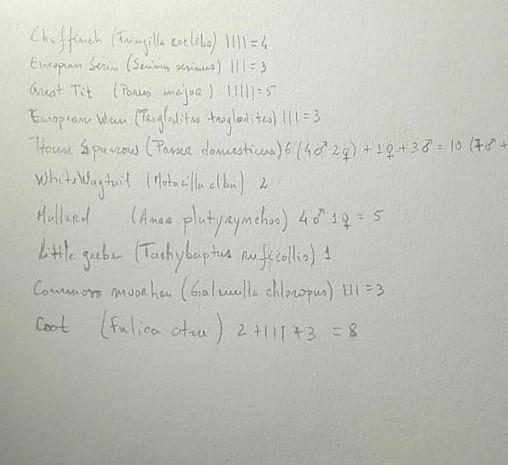 The list of birds observed
The list of birds observed 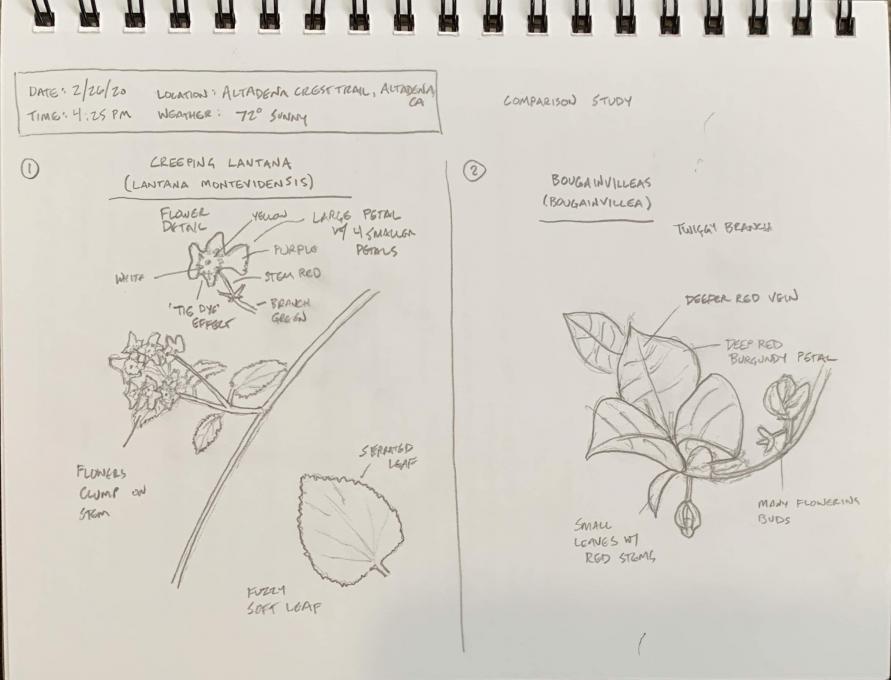 1. A deeper level of detail was observed on each plant during the comparison study. Working back and forth between each plant/sketch provided specific items to look at on each.
2. I like an equal balance of writing/data and drawing in my journal. I feel all provide valuable observation cues and information for reference later.
1. A deeper level of detail was observed on each plant during the comparison study. Working back and forth between each plant/sketch provided specific items to look at on each.
2. I like an equal balance of writing/data and drawing in my journal. I feel all provide valuable observation cues and information for reference later. 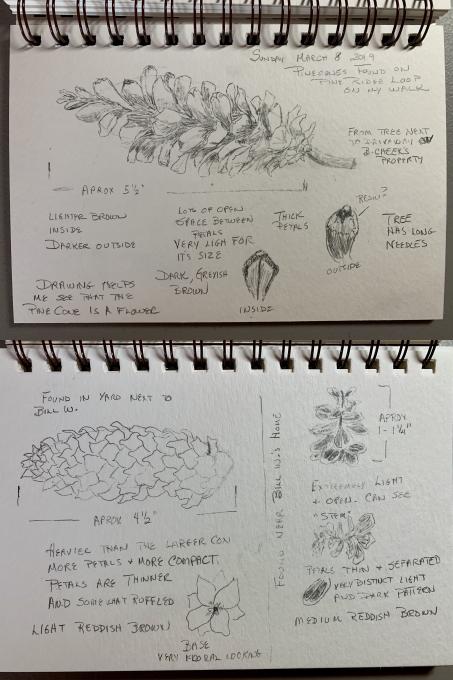
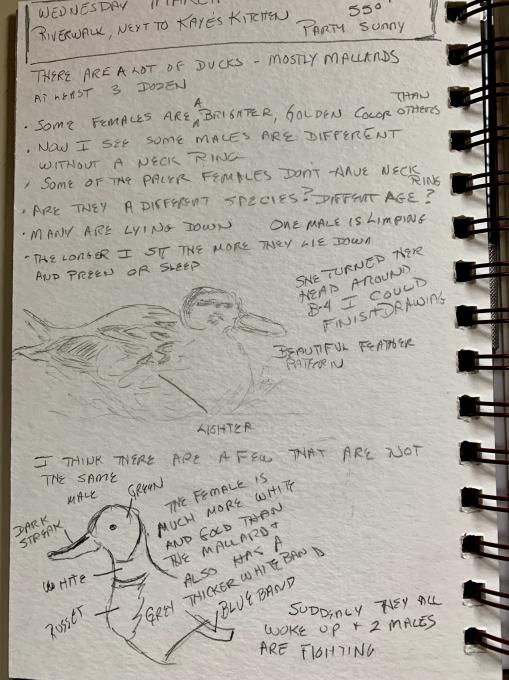
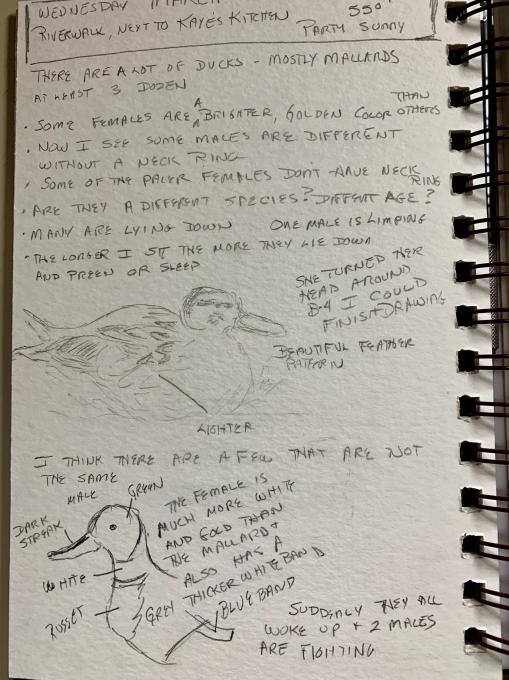
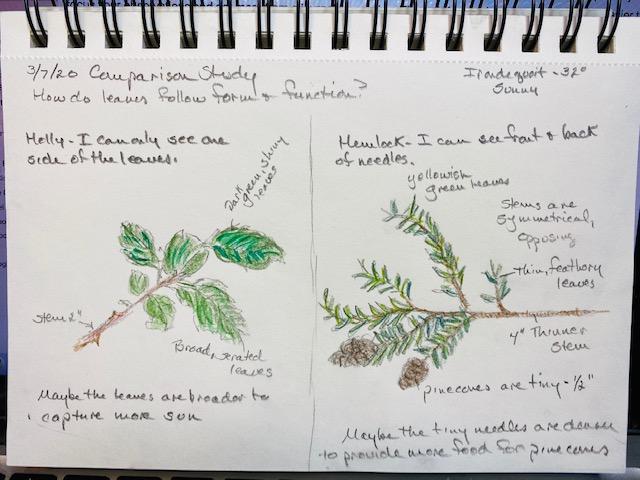 This is my comparison study, holly and hemlock. I did see many differences that I might not have otherwise noted.
This is my comparison study, holly and hemlock. I did see many differences that I might not have otherwise noted. 